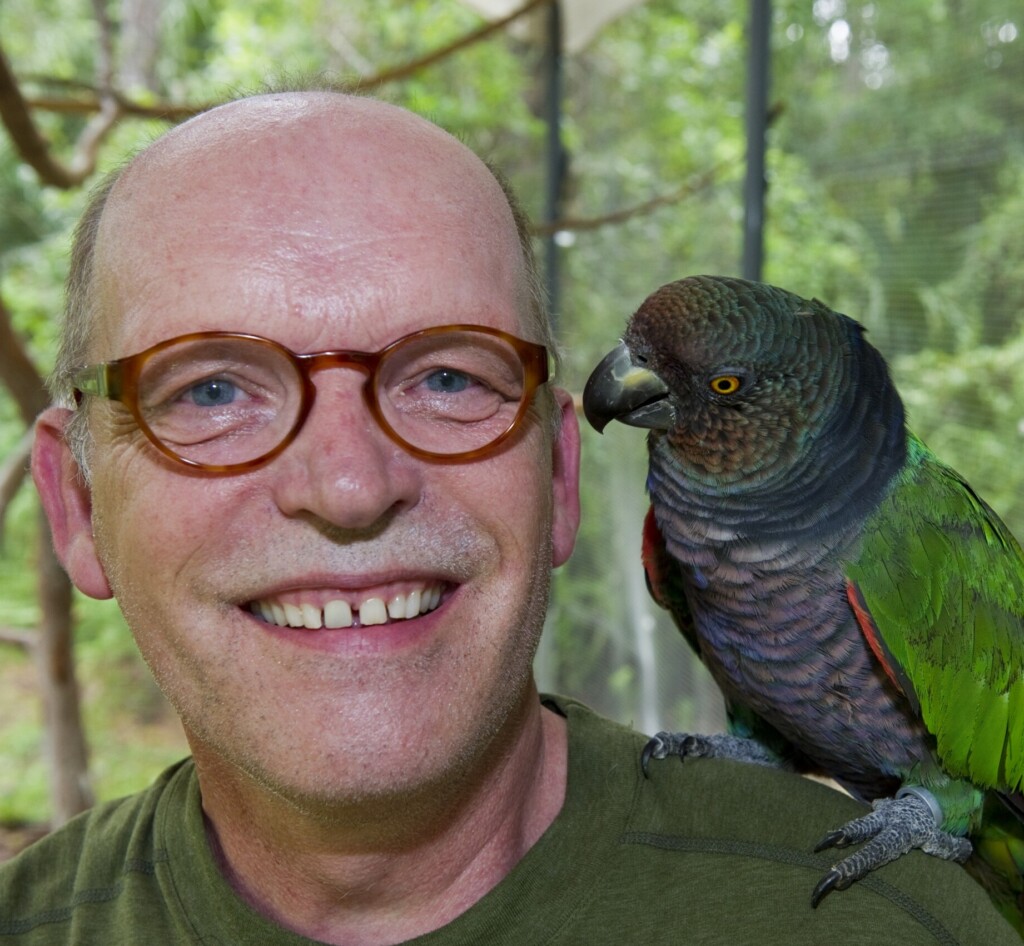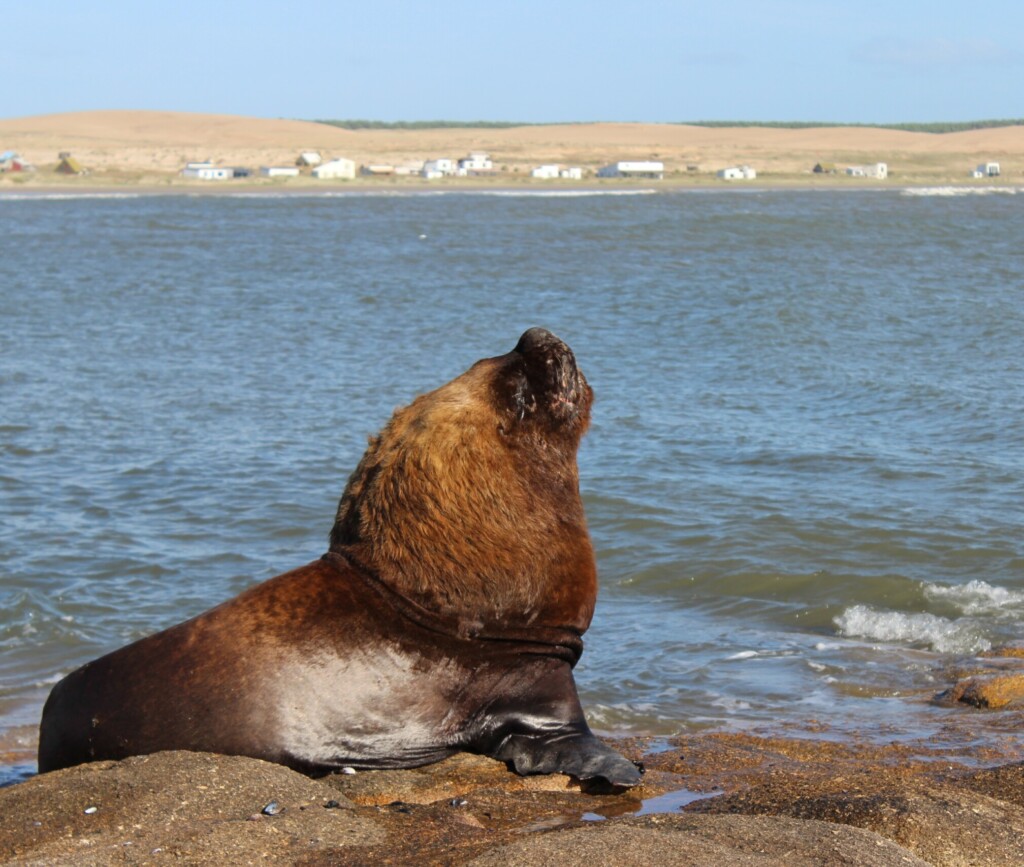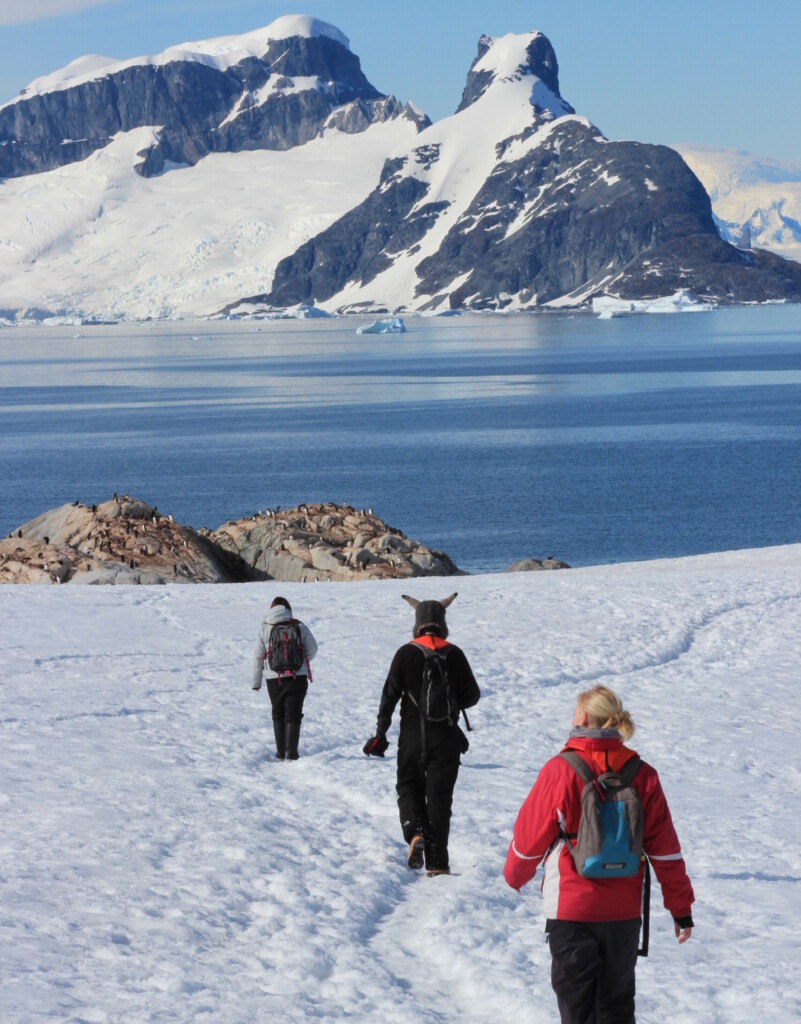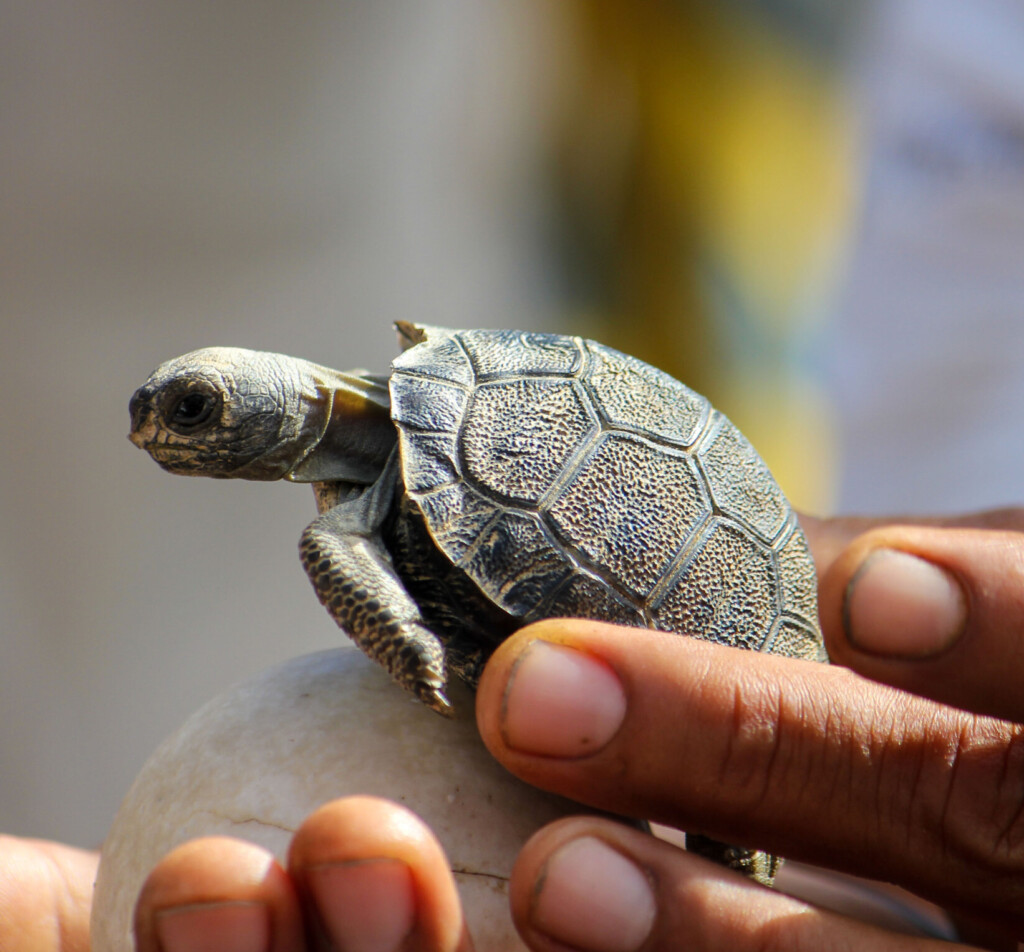Academic Animals: Making Nonhuman Creatures Matter in Universities
By Charles Bergman
Originally published in 2005
For two weeks of March, 2000, in the vast jungle along Mexico’s southern border with Belize, I joined a team of biologists and hounds in chasing and capturing a wild jaguar. I was in Mexico as a Fulbright Scholar. It took us nearly two weeks of hard work and unflagging persistence to locate, track, and finally tree this jaguar in the Biosphere Reserve of Calakmul.
Beyond the exhilaration of seeing a wild jaguar, a particular gesture made by all of us toward the jaguar grabbed my imagination. It happened while the biologists worked with the tranquilized cat, after it had been lowered to the ground. With the animal asleep, these professionals swung into efficient action, weighing it, measuring it, taking samples of blood and fur and parasites. Then they fitted the jaguar with a radio collar, which was the main purpose in capturing the animal. One of the most beautiful animals in the world, the jaguar is the third largest of all the cats, behind only the tiger and the lion. Endangered throughout its range in Latin America, the jaguar remains the least studied of all the major felids. Using radio collars, biologists can study—and work to save—this elusive animal, using the signals from the transmitter to gather data on range, habitat needs, and behavior.

As we worked, each of us stopped what we were doing, in our own time and way, to reach out and touch the sleeping jaguar. It was a simple and reverent gesture of contact, feeling the animal’s powerfully muscled body, stroking his magnificent rosette-spotted fur. The jaguar was a powerful, living presence. For over twenty years, I have written about wildlife professionally in books and national magazines. I have been privileged to see and study some of the most wonderful wild creatures in the world. Yet touching this jaguar was the experience of a lifetime.
Since returning to the United States, I often find myself evoking this deeply satisfying moment, when the value of a life was contained in a touch. And I find myself wondering what happens to this sense of the presence of animals, this moment of contact with other creatures, inside the academy. The touching of the jaguar in the Mexican jungle dramatizes for me the absence of the animal as an animal in our universities. Despite important pockets of interest, I am struck by the general lack of concern for animals in universities. It seems to me that nonhuman animals have not fared well in American higher education.

When I refer to academic animals, I am not referring directly to animal experimentation in universities, though this is a related issue. Rather, I refer to the ways academics are likely to conceptualize nonhuman animals—the animals we construct, the animal as it appears in our various discourses. There are various versions of the academic animal, but these abstract versions of the animal are I believe major barriers in our abilities to understand animals more fully and realize more clearly our obligations to the other creatures with whom we share this wonderful life.
It should be clear that the animal movement has penetrated much more deeply into the popular imagination that it has into the academic mind. I say this as a person who writes extensively on wild animals for national magazines such as Smithsonian and others. Indeed, I published an article on my encounter with the jaguar in the October 2000 issue of Smithsonian.
The wonders of animal life are on twenty-four hour display on cable TV’s Animal Planet station, as well as the numerous programs on the Discovery Channel and the Nature documentaries. Perhaps more telling, since they relate directly to the public’s fascination with questions about animal minds, is the number of cover stories run in the 1990s by such magazines as Time, Newsweek, and U.S. News & World Report on the advances in our understanding of animals’ use of language and their mental abilities.
As a society we face important questions about how we can make sense out of animals as autonomous living creatures, as well as our ethical relations with them. There are major intellectual challenges in this, of course, but that does not make the task any less important. Yet inside the academy the resistance to taking animals seriously is pervasive, and not always subtle. To study nonhuman animals in ways that try to accord them value and dignity is still likely to strike most academics as quaintly marginal, even risible, an easily dismissed sentimentality.
Shortly after returning from Mexico, for example, I participated in a conference on animals and representation. Attended mostly by professors in the humanities and in cultural studies, the conference drove home to me the difference between my experience of touching the jaguar in the jungle and the way animals are processed in the academy.
Perhaps it should come as no surprise, but I was still disturbed by the ways in which most of the speakers were willing, almost glibly, to dismiss the animal as animal. Some of the people attending the conference cared about creatures, but for the most part the conference abandoned the animals—talking about what animal representations mean to us and almost nothing about how our representations affect the animals or the ethical issues involved in representation. The creatures themselves vanished under a somewhat strange amalgam of attitudes ranging from post-structural skepticism to more traditional concerns with human superiority, anthropomorphism, and anti-sentimentality. The actual animal seemed almost an embarrassment, a disturbance to the symbolic field. Highly literate people went almost systematically about obliterating the actual animal.
As part of the conference, for example, Jane Goodall was a featured speaker. She spoke not just to the conference participants, but at an open event that produced a huge local crowd, drawn by her commitment to and knowledge of chimpanzees and animals.

Anyone who has seen her speak knows that it’s something of a cultural phenomenon. Afterwards, however, many at the conference dismissed her forty years of work as sentimental and not scientifically rigorous. Something about her emotional and moral commitment to animals was, I believe, uncomfortable for many. Yet she spoke directly to a huge hunger in the general population for knowledge and a deeper understanding about animals. This is directly akin, I believe, to the desire we all felt in the Mexican jungle to touch the jaguar.
In academic discourses we continue to have trouble speaking about animals in ways that are not dismissive or reductive. For many scientists, the danger is to treat them as Cartesian automatons, not autonomous creatures. Their behaviors are explained by instincts, stimulus-response mechanisms or genetic programming.
For humanists, the tendency is to treat animals as little more than allegories of human fear and desire. Or the animal is given up as radically unknowable beneath human representation. Animals in the humanities? It seems almost an oxymoron.
Alienating animals from their own lives is a danger in wildlife biology, as well, where researchers often must separate their personal from their professional responses to the creatures they study so intimately. The jaguar we fitted with the radio collar will disappear in the biological studies produced from the research. With the data from several collared jaguars, a statistical composite of the jaguar in the area—the jaguar as species—will be constructed. Important information, to be sure. Yet as one researcher told me, studying another tropical species, the composite portrait describes the creature as type, “a platonic animal,” to use her words. Because it portrays a statistically typical animal, it really is a picture of no actual animal.
It’s not that these views are wrong, despite a lot of mutual suspiciousness. It’s that they each treat animals as though they have no lives of their own. They are treated as if they live somehow outside their own lives, moved by forces over which they have no control, forces that are somehow not them. Denied mind and subjectivity and agency, they are living robots. Their lives are wholly contingent. In what ways can we begin to represent animals that responsibly place them inside their own lives?

Our obligations to the other creatures on this planet is one of the great ethical questions of our times. Yet the prejudice against animals—“speciesism,” as it’s been called—slows our progress in sorting out these ethical issues. Compare the progress made recently with other major ethical and social issues. In his now-famous book, Animal Liberation: A New Ethics for Our Treatment of Animals (Avon 1975; 2nd ed. 1990), Peter Singer gave a new academic respectability to animal issues and stimulated a renewed vigor in social-action campaigns on behalf of animals. He also explicitly linked animals with other social liberation movements.
These other movements are now well established in universities with vigorous multi-disciplinary programs in gender studies, ethnic studies, and so forth. Not so animals. As far as I know, there is no “animal studies program” in any American university. In fact, the phrase “animal studies” does not even exist except as I am here using it informally.
Even making the comparison between animals and historically oppressed people is much more likely to offend the people involved than ennoble the cause of animals. This even though many feminists, like Carol J. Adams in The Sexual Politics of Meat: A Feminist-Vegetarian Critical Theory (Continuum 1990), have argued animals and women have both been constructed as “others,” resulting in similar forms of oppression and exploitation for both.
Aristotle in his Politics likened the human superiority over animals to the rule of the soul over the body, men over women, and even masters over slaves. Yet while we would not now condone language that makes women, say, symbols of the “passions,” or makes Native Americans symbols of, say, “primitiveness,” it is still common to find academics using startling clichés and stereotypes in speaking about animals. Like Shakespeare’s Caliban, animals are still too widely described as grossly mindless, stubbornly inferior, “this thing of darkness.”
Such attitudes are increasingly anachronistic. I do not mean to suggest that animal studies are commensurate with studies of women’s issues or issues in other human groups. Understanding animals presents its own unique challenges: animals leave no texts, at least directly, and do not speak for themselves. Additionally, there is the tangled issue of anthropomorphism. Nevertheless, compelling research on animals in recent decades has dramatically changed our image of animal consciousness and our understanding of our relationships with animals.
We are experiencing an exciting new wave of interest in animals. Animals are moving out of biology and zoology departments and into fields once way out of bounds for them. The conference I referred to earlier, for example, was one of four major international and multidisciplinary conferences to be held on animal issues in the last two years. Also encouraging, the Conference of the Modern Language Association has in the last two years sponsored three panels on animals which might be described as “pro-animal,” that is, which move beyond studies of animal imagery in, say, Shakespeare or Moby Dick.
Such conferences are made possible by a wealth of new research on animals in a wide range of fields. For some time, the conversation about human-animal relations has been largely dominated by terms derived from philosophical ethics. Other fields are now adding to the conversation in ways that may expand our possibilities for understanding this important dimension of human life. Consider for example just a few of the titles to have appeared in the last few years, selected to give a sense of disciplinary and theoretical range: Keith Thomas, Man and the Natural World: A History of the Modern Sensibility (Penguin/Random House 1983); E. O. Wilson, Biophilia: The Human Bond with Other Species (Harvard 1984); Harriet Ritvo, The Animal Estate: The English and Other Creatures in the Victorian Age (Harvard 1987); Andrew Linzey, Animal Theology (University of Illinois 1994); Carol J. Adams and Josephine Donovan, Animals and Women: Theoretical Explorations (Duke 1995); M. Coetzee, The Lives of Animals (Princeton 1999); Eileen Crist, Images of Animals: Anthropomorphism and Animal Mind (Temple 1999); Steven M. Wise, Rattling the Cage (Perseus 2000); Steve Baker, The Postmodern Animal (Reaktion 2000).
One hopes that this interest in animals is more than a passing academic fashion. My own belief is that this new interest is fueled in large part by the broader social concerns for the fates of animals, whether wild animals increasingly facing extinction and endangerment, or captive animals facing all manner of abuses. Another important sign that this interest reflects a deep shift is that our understanding of animals, and their mental abilities, has been changing in recent years. Wildlife and conservation biology have given us a much greater appreciation for the wonders of animals and their complex behaviors. Also, the new field of cognitive ethology, which studies animal mentality as a kind of behavior, is changing our view of the animal mind. While it is a field with many challenges and controversies, we seem to be in the process of an almost revolutionary advance in our understanding of animal intelligence.

A good overview to this field can be found in Colin Allen and Marc Bekoff’s Species of Mind: The Philosophy and Biology of Cognitive Ethology (MIT 1997). Donald Griffin especially stimulated the emergence of the field in such books as Animal Minds (Chicago 1992) and Animal Thinking (Harvard 1884), arguing that the way to understand animal intelligence was to look not at the stereotypical behaviors of species. Rather, the flexibility, variability, and purposiveness of the individual animal offer insight in animal intelligence. He and other early researchers stressed evolutionary continuity in the emergence of human intelligence. Increasingly, researchers are focusing on understanding animal minds and thought as distinct from human thought. As Marc D. Hauser, professor of psychology and neuroscience at Harvard, writes in Wild Minds: What Animals Really Think (Henry Holt 2000), “We share the planet with thinking animals . . . . Although the human mind leaves a characteristically different imprint on the planet, we are certainly not alone in this process” (257).
The boundaries between animals and humans are changing. The frontier is porous and the implications for our relationships with animals are great. There is much in the academy we can do on behalf of animals. I hope this new interest in animal studies reflects a concern for the lives of real animals. We need a change in our attitudes toward animals, so that they are not so easily dismissed and forgotten, even as we speak and write about them. Animals are not only texts that we produce. We need an ethos more favorable to animals, more open to the creature as a living presence.
That means more multi-disciplinary study to help us overcome the limitations of perspective in our individual disciplines. It also means more conferences, more panels, more publications, and more courses in universities. I would urge anyone interested in animal issues to read widely (and wildly?) about animals, ranging beyond the confines of particular disciplines. It’s harder to treat a whale as only a linguistic artifact, a symbol, when you learn about discoveries in its mental abilities, for example. It’s harder to treat an animal as a genetic program after savoring the presence of animals in W. S. Merwin’s poems.
Most important, I would urge us to pay greater heed to the animals themselves. After the grueling challenges of chasing the jaguar in the rainforest of Mexico—and touching it—one comes away with an increased respect for the animal’s intelligence and value. We need to care as much for the worlds of being as we do for the worlds of meaning.


